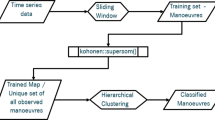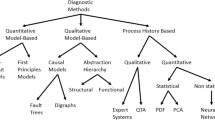Abstract
This article explores the capacity of self-organizing maps (SOMs) for analysing non-life insurance data. Contrary to feed forward neural networks, also called perceptron, a SOM does not need any a priori information on the relevancy of variables. During the learning procedure, the SOM algorithm selects the most relevant combination of explanatory variables and reduces by this way the collinearity bias. However, the specific features of insurance data require adapting the classic SOM framework to manage categorical variables and the low frequency of claims. This work proposes several extensions of SOMs in order to study the claims frequency of a portfolio of motorcycle insurances. Results are next compared to these computed with variants of the k-mean clustering algorithm.







Similar content being viewed by others
Notes
In our approach, codebooks are randomly chosen. An alternative consists to use the initialization procedure of the k-means algorithm, presented in Sect. 2.2.
A variant of this algorithm consists to recompute immediately the new position of centroids after assignment of each records of the dataset.
References
Arthur D, Vassilvitskii S (2007) \(K\)-means\(++\): the advantages of careful seeding. In: Proceedings of the 18th annual ACM-SIAM symposium on discrete algorithms, SODA’ 07, pp 1027–1035
Benzécri JP (1973) L’ analyse des données, T2, l’ analyse des correspondances. Dunod, Paris
Brockett P, Cooper W, Golden L, Pitaktong U (1994) A neural network method for obtaining an early warning of insurer insolvency. J Risk Insur 61(3):402–424
Brockett P, Xia X, Derrig R (1998) Using Kohonen’s self-organizing feature map to uncover automobile bodily injury claims fraud. J Risk Insur 65(2):245–274
Brockett P, Golden L, Jang J, Yang C (2006) A comparison of neural network, statistical methods, and variable choice for life insurers’ financial distress prediction. J Risk Insur 73(3):397–419
Burt C (1950) The factorial analysis of qualitative data. Br J Psychol 3:166–185
Cottrell M, Ibbou S, Letrémy P (2004) SOM-based algorithms for qualitative variables. Neural netw 17:1149–1167
Greenacre MJ (1984) Theory and applications of correspondence analysis. Academic Press, London
Hainaut D (2018) A neural-network analyzer for mortality forecast. ASTIN Bull 48(2):1–28
Huysmans J, Baesens B, Vanthienen J, Van Gestel T (2006) Failure prediction with self organizing maps. Expert Syst Appl 30(3):479–487
Hertz J, Krogh A, Palmer RG (1991) Introduction to the theory of neural computation. Addison-Wesley, Reading
Kohonen T (1982) Self-organized formation of topologically correct feature maps. Biol Cybern 43(1):59–69
Lebart L, Morineau A, Warwick KM (1984) Multivariate descriptive statistical analysis: correspondence analysis and related techniques for large matrices. Wiley, New York
Lloyd SP (1957) Least square quantization in PCM (Bell telephone laboratories paper. Published in journal much later: Lloyd., S. P., 1982). IEEE Trans Inf Theory 28(2):129–137
Ogunnaike RM, Si D (2017) Prediction of insurance claim severity loss using regression models. In: Proceedings of the 13th conference on machine learning and data mining. Springer, New York, pp 233–247
Ohlsson E, Johansson B (2010) Non-life insurance pricing with generalized linear models. Springer, New York
Rosenblatt F (1958) The perceptron: a probabilistic model, for information storage and organization in the brain. Psychol Rev 65(6):386–408
Sakthivel KM, Rajitha CS (2017) A comparative study of zero-inflated, hurdle models with artificial neural network in claim count modeling. Int J Stat Syst 12(2):265–276
Wütrich M, Buser C (2017) Data analytics for non-life insurance pricing. In: Lectures notes. https://papers.ssrn.com/sol3/papers.cfm?abstract_id=2870308
Viaene S, Derrig RA, Baesens B, Dedene G (2002) A comparison of state-of-the-art classification techniques for expert automobile insurance claim fraud detection. J Risk Insur 69:373–421
Acknowledgements
I gratefully acknowledges the BNP Cardif Chair “Data Analytics and Models for Insurance” for its financial support. I also thank Michel Denuit from the UCL for his constructive advices.
Author information
Authors and Affiliations
Corresponding author
Additional information
Publisher's Note
Springer Nature remains neutral with regard to jurisdictional claims in published maps and institutional affiliations.
Rights and permissions
About this article
Cite this article
Hainaut, D. A self-organizing predictive map for non-life insurance. Eur. Actuar. J. 9, 173–207 (2019). https://doi.org/10.1007/s13385-018-0189-z
Received:
Revised:
Accepted:
Published:
Issue Date:
DOI: https://doi.org/10.1007/s13385-018-0189-z




